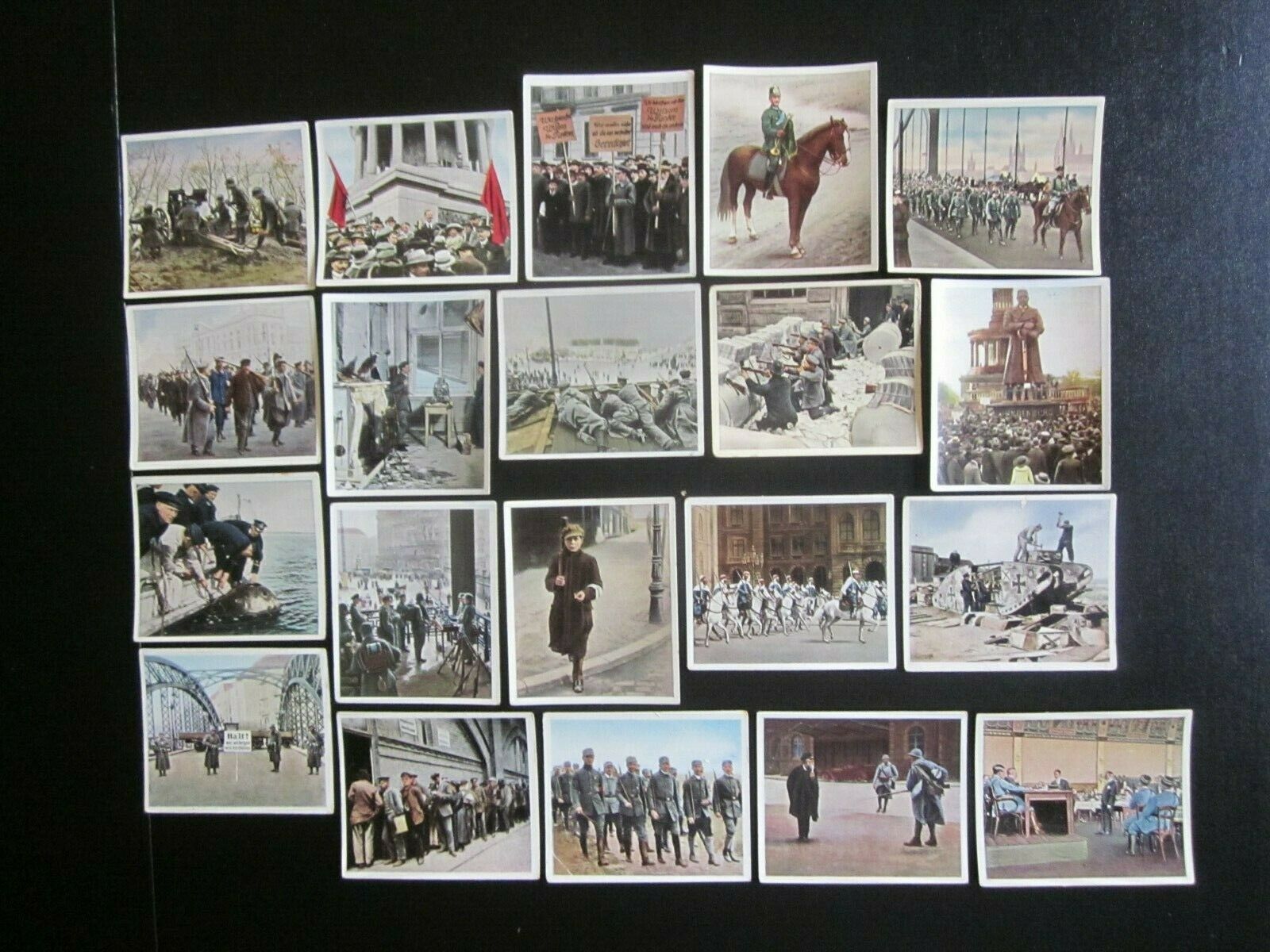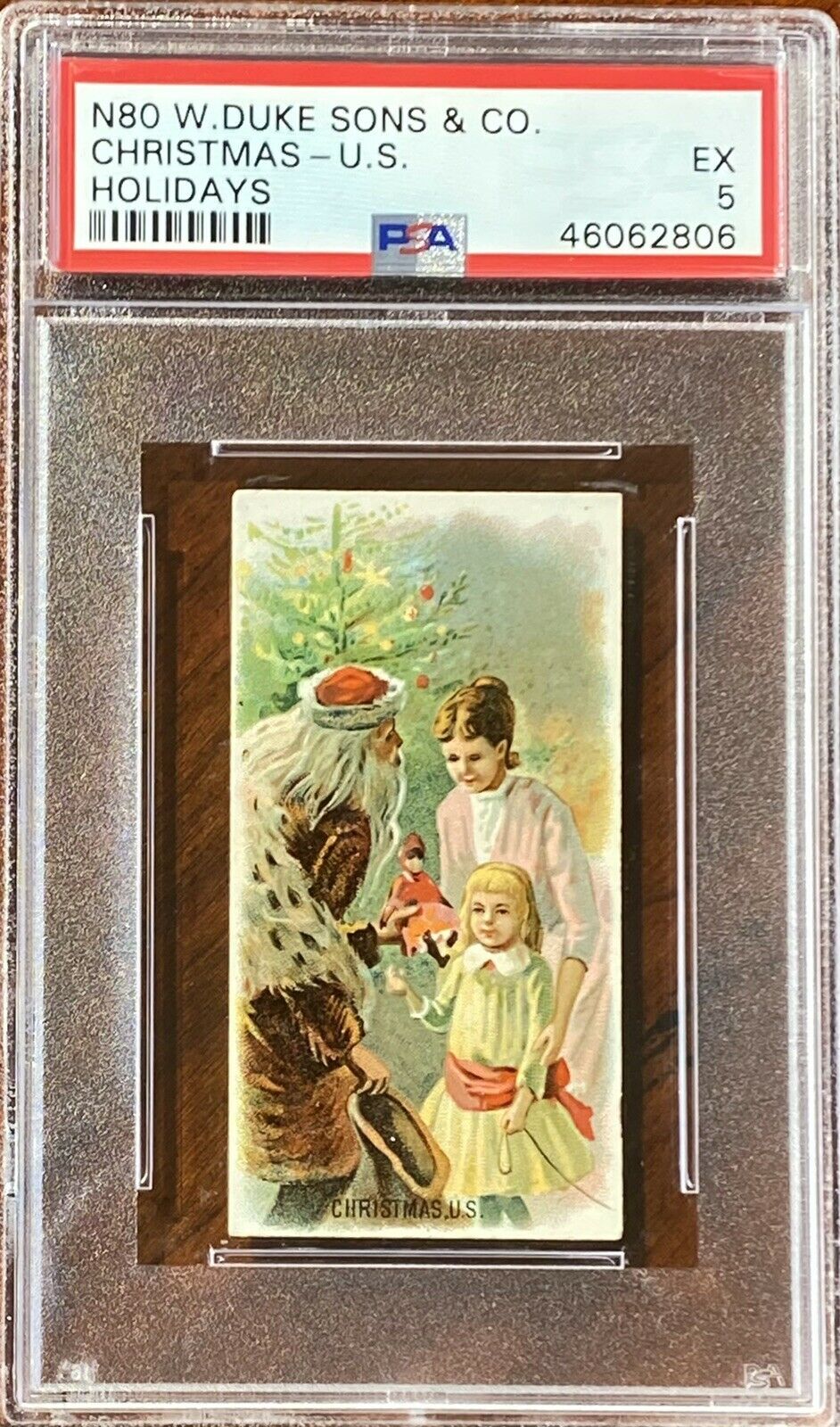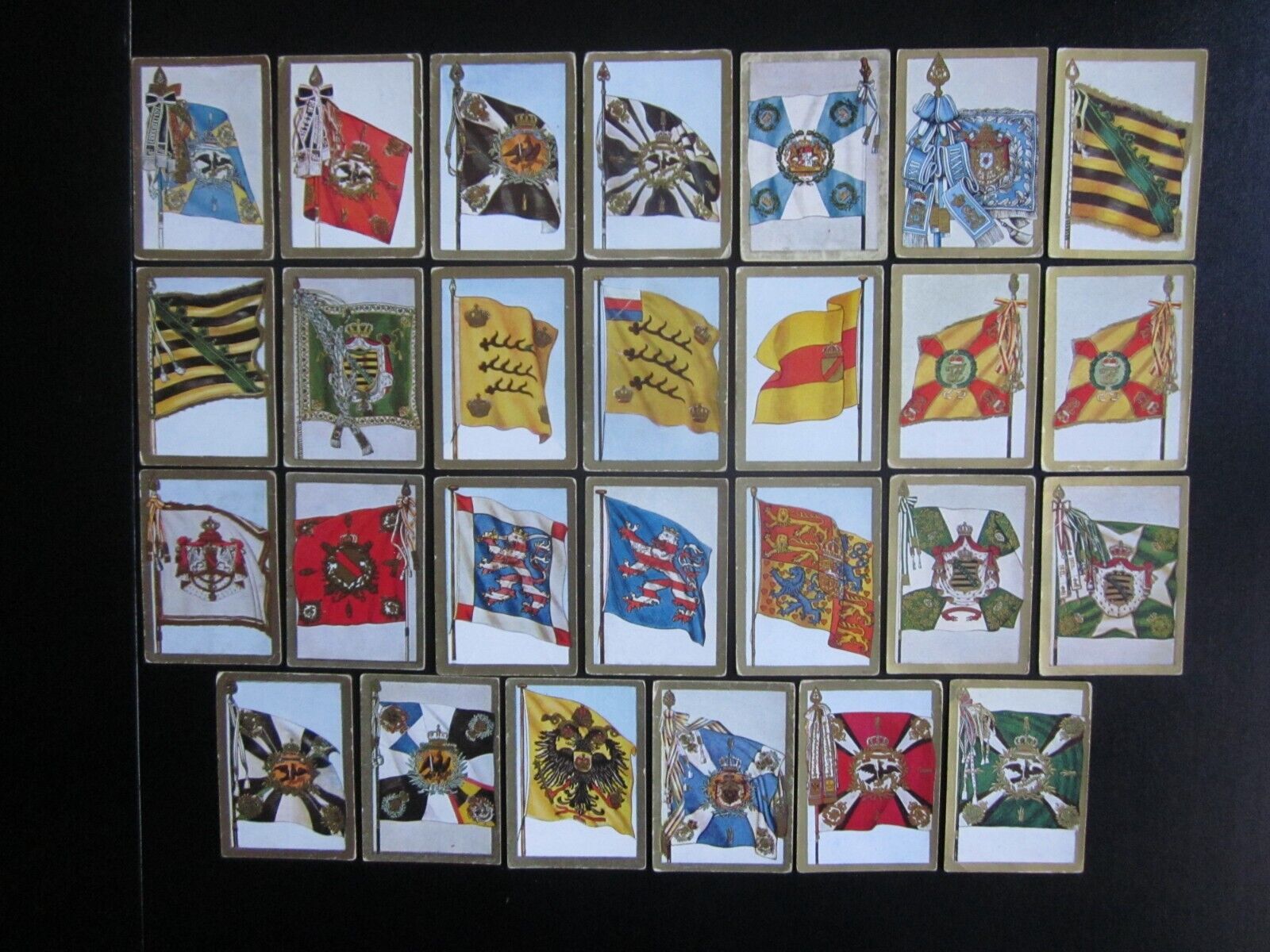-40%
20 German cig. cards: Chaos / Revolution in Germany after WW1, issued 1937
$ 2.9
- Description
- Size Guide
Description
Offered here are 20 original German cigarette cards of events in Germany and around the world after World War 1, issued in 1937 by a number of cigarette companies, including the Eckstein-Halpaus Cigarette Co. of Dresden for the albumDie Nachkriegszeit
(The Postwar Era). Pictured here are:
No. 1
: The Resistance of the Germans on the Front (November 1918). At the end of the war the German army was still not defeated, but the turn of events puts great pressure on it, when Bulgaria sues for peace with the Allied on September 27th and Austria does the same on October 27th. Inside Germany revolutionary cells are forming throughout the country. So the army was no longer fighting for victory, but only for an honorable peace. The picture on this card shows the last activity of German artillery in the Champagne region of France.
No. 2:
The November Revolution in Germany (November 1918).
On October 21, 1918 a government amnesty released many political trouble-makers from prison. They promptly stirred up the masses to open revolt. It first appears on the high seas fleet on October 30th, just as it was about to take to see to try to help the beleaguered army. Pictured here is an agitator who is calling for peace at any cost and the abdication of the emperor.
No. 3:
Wilson's Fourteen Points (November 1918). On January 8, 1918 Woodrow Wilson announced his peace plan, the "Fourteen Points". Point 3 spoke of economic freedom for all signatories, while Point 4 spoke of disarmament. These points made a great impression on the German people. To the end, they hoped that these points would be the basis for an honorable peace. Pictured here are German civilians carrying signs that read "Wilson's 14 Points are ours as Well."
No. 6:
The War is Ended With a Trumpet Signal (November 1918). Up to the very last moments of the war, it was bitterly fought. Sometimes commanders even kept the cease-fire, which went into effect on Nov. 11th at 11:15 am, a secret from their troops, until finally trumpet signals let all troops know of the end of fighting. Captain Zebrowski, today a police captain, gave the signal on the German side.
No. 7
: The Orderly Return of the Army from the Front (September 1919). After the signing of the armistice (Nov. 11, 1918) Germany had to withdraw all of its troops from Belgium, France and Alsace-Lorraine within 14 days. Germany had 30 days to withdraw its troops from the zones along the Rhine River that would be occupied by the victorious powers (primarily France and England). This included the cities of Mainz, Koblenz and Cologne. Despite the unimaginable difficulties involved in such an undertaking, it was fulfilled in an orderly manner. The picture on this card shows German front troops returning home across the Rhine River bridge at Cologne in December of 1918.
No. 9:
The Struggle for Power (December 1918). After the abdication of the Kaiser in December 1918 a “Committee of People’s Representatives” (3 Socialists: Ebert, Scheidemann and Landsberg) and 3 Independents (Barth, Haase and Dittmann) took over government authority. Because of the military strength of the “Red People’s Naval Division” it looked at first as if the radicals would assume power in Germany. Pictured here are members of the armed Workers Battalion marching through Berlin.
No. 11:
The Fight for the Berlin Imperial Residence ((December 1918). On December 24
th
bloody fighting broke out around the Imperial Residence. Government troops had to use artillery and mortars to clear out the facility of fighters from the “Red People’s Naval Division” who left the residence on December 25
th
. On the same day, Franz Seldte founded the “Stahlhelm” (Steel Helmet) military group in Magdeburg. Pictured here is a shot-up room of the Residence.
No. 12:
Christmas 1918 (December 1918). After the Allies began their occupation of the Rhineland on December 20, 1918, unrest spread in Germany. At the same time, German troops returning from the front begin forming voluntary militia-groups that had to try to restore order.
No. 13:
Fighting for Several Days in Berlin's Newspaper District (January 1919). On November 5, 1919 street fighting flared up again in Berlin. They took place primarily in the Newspaper District, that had been previously cleared by government troops under General von Luettwitz after fighting from January 5
th
to 12
th
. One of the results of the renewed fighting was the capture and execution of Karl Liebknecht and Rosa Luxemburg, founders of the German Communist movement, on Janaury 15
th
. Pictured here is a barricade of newspapers during the fighting.
No. 20:
Protests Against the Versailles Treaty (August 1919).
The Treaty was signed by Germany on June 28th, but it did not go into effect right away. The German people who were to lose 13% of their territory, 26% of its coal, 92% of its commercial fleet and 100% of its colonies protested with a loud "No!". Pictured here is a protest before the statue of "Iron Hindenburg" in Berlin.
No. 24:
Mine Clearing Operations. During the war the German navy created many minefields along the coast, with over 34,000 in the Baltic Sea alone. According to the Versailles Treaty they all had to be defused or destroyed. This operation that did not end until July of 1921 employed some 10,000 men. The dangers and loss of life involved in this operation earned it the name "The Fast Lane to Heaven." Pictured here: recovering mines in the Baltic Sea.
No. 27:
The Kapp Putsch (March 1920). The “Brigade Ehrhardt” does not follow orders from the Versailles Treaty to disband and it joins up with General von Luettwitz. On March 3, 1920 it declares a Putsch putting Kapp at the head of a new government. The elected government under Friedrich Ebert quickly evacuates Berlin for Southern Germany and proclaims a general strike. The Putsch government under Kapp collapses on March 17
th
.
No. 28:
The "Red Army" in Postwar Germany (April 1920). In response to the failed "Kapp Putsch" in March 1920, a "Red Army" of about 100,000 men was formed in Central Germany and in the Ruhr region. They are put down in violent confrontations by Generals von Epp and von Watter and order was restored by April 18th. In the process, however, German troops entered the "neutral" (occupation) zone, which they were forbidden by treaty to do. Pictured here: a young guard of the Red Army in Germany.
No. 31:
The Occupation of the Rhineland (July 1920). From mid-November to mid-December 1918 the victorious Entente Powers moved 50 divisions into the occupied Rhineland region, a larger army than Germany's own during peacetime before the war. With a civilian population of only 6 million in that region, this amounted to a foreign soldier for every 10 civilians. The French headquarters was in the city of Mainz. Pictured here: French colonial cavalry in Wiesbaden. They did not leave until June of 1930.
No. 36:
Germany “Fulfills Its Obligations” (December 1920). After the war Germany was no longer permitted to have fortresses, airships, warplanes, submarines, tanks or anti-aircraft weapons. The army could only be 100,000 men, the navy only 15,000 men and the police 150,000 men. These targets met by Germany as of December 31, 1920.
No. 37:
New Internal Unrest (January 1921). When the demands of the Reparations Conference meeting inParis (January 24-29, 1921) became known in Germany, public unrest was the result. Germany was told to pay 226 Billion gold Marks (compared to 4 Billion Gold Marks demanded by Germany from France in 1871). Germans asked themselves: “Should Germany Sign the Agreement?” The debate was hot and furious. Our picture shows a checkpoint during the political fighting. The sign reads: “Stop. Whoever goes past this sign will be shot.”
No. 45:
The Beginning of the Inflation Spiral (September 1921). Although the German Mark has now sunk to its lowest point in history, the German people still have confidence in it. One small consolation: in Austria things are much worse. The authorities quickly introduce measures to alleviate widespread hunger.
No. 47:
The Birth of the S.A
.
(November 1921). Resistance against the founding of the Nat’l Soc. Workers Party grew quickly. A meeting of the party on November 4, 1921 was attacked by opponents, but the 46 security men at the meeting were able to thwart this attempt. From that point on these men became known as the “Sturmabteilung” (Storm Unit).
No. 62:
Passive Resistance (February 1923).
the German government proclaimed a program of passive resistance to the invasion of the Ruhr by the French and Belgian troops. Wherever the French appear, all stores and signs of life shut down and the streets empty.France escalates by expelling all high government officials in the region. Pictured here is how the French enforced their will in Essen.
No. 64:
Political Trials (April 1923). After the bloody unrest on Saturday, March 31, 1923 in Essen, the French arrest the directors of the coal mines there, whom they believed to be responsible for the riots. They later also arrested Krupp, von Bohlen and Halbach. They same happens to many other leaders of the local city administration and economy, for example, Mayor Jarres of Duisburg, Mayor Havenstein of Oberhausen and Mayor Schaefer of Essen. Our picture shows Krupp, von Bohlen and Halbach before a French Tribunal in Werden.
On the back of the cards at the bottom are directions on how people collecting these pictures in the 1930s could get the album for the pictures. The cards from the Waldorf-Astoria Co. read: "You can get the album for 1 Reichsmark at any cigarette store or by paying this amount to the following Post Office checking account: Munich 1979." Please note: the number "1979" here is
not
a date/year, but a postal account number.
Each card measures 2 and 3/8 inches by 2 inches.
With multiple purchases, please wait for invoice for reduced shipping.










